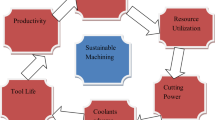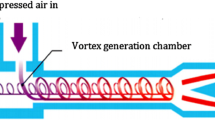Abstract
In this paper, final surface accuracy in turning the super alloy Monel K-500 is studied. The experiments were conducted on the basis of the design of experiment methodology considering four inputs of tool nose radius, feed rate, depth of cut, and cutting speed, and three outputs of surface roughness, dimensional deviation, and tool wear. The aim of this work is to identify these three phenomena to achieve a desirable machined surface with acceptable finishing and the least deviation from nominal dimensions under different parametric conditions. It was observed that the quality of the machined surface in the direction of the machining length is not constant and, in some trials, the values of Ra increase considerably at the end of the machining length. The results show that cutting speed can improve surface accuracy, in a way that the more the cutting speed, the less the dimensional deviation. Less depth of cut and tool radius affect dimensional deviation as well. Although it has a small effect on dimensional deviation, feed rate plays the most important role in controlling tool wear. Finally, on the basis of Grey relational analysis, a simultaneous optimization is carried out on surface roughness, dimensional deviation, and tool wear values. In order to minimize these responses, optimal parametric conditions are presented. A satisfying correspondence was observed between the predicted results and the confirmation observations.
Similar content being viewed by others
References
Thakur DG, Ramamoorthy B, Vijayaraghavan L (2009) Study on the machinability characteristics of superalloy Inconel 718 during high speed turning. Mater Des 30:1718–1725
Altin A, Nalbant M, Taskesen A (2007) The effects of cutting speed on tool wear and tool life when machining Inconel 718 with ceramic tools. Mater Des 28:2518–2522
Ginting A, Nouari M (2009) Surface integrity of dry machined titanium alloys. Int J Mach Tools Manuf 49:325–332
Grzesik W (2008) Influence of tool wear on surface roughness in hard turning using differently shaped ceramic tools. Wear 265:327–335
Subhas BK, Bhat R, Ramachandra K, Balakrishna HK (2000) Dimensional instability studies in machining of Inconel 718 nickel based superalloy as applied to aerogas turbine components. J Eng Gas Turbines Power 122:55–61
Capello E (2005) Residual stresses in turning part I: Influence of process parameters. J Mater Process Technol 160:221–228
Guo YB, Li W, Jawahir IS (2009) Surface integrity characterization and prediction in machining of hardened and difficult-to-machine alloys: a state-of-art research review and analysis. Mach Sci Technol 13:437–470
Dhar NR, Paul S, Chattopadhyay AB (2002) Machining of AISI 4140 steel under cryogenic cooling—tool wear, surface roughness and dimensional deviation. J Mater Process Technol 123:483–489
Krishnaiah K, SHahabedeen P (2012) Applied design of experiments and Taguchi methods, 1st edn. PHI Learning Pvt, New Delhi
Ulutan D, Ozel T (2011) Machining induced surface integrity in titanium and nickel alloys: a review. Int J Mach Tools Manuf 51:250–280
Benardos PG, Mosialos S, Vosniakos GC (2006) Prediction of workpiece elastic deflections under cutting forces in turning. Robot Cim-Int Manuf 22:505–514
Griffith B (2001) Manufacturing surface technology: surface integrity and functional performance. Taylor & Francis, New York
Devillez A, Le Coz G, Dominiak S, Dudzinski D (2011) Dry machining of Inconel 718, workpiece surface integrity. J Mater Process Technol 211:1590–1598
Pawade RS, Joshi Suhas S, Brahmankar M (2008) Effect of machining parameters and cutting edge geometry on surface integrity of high-speed turned Inconel 718. Int J Mach Tools Manuf 48:15–28
Dhar NS, Kamruzzaman M (2007) Cutting temperature, tool wear, surface roughness and dimensional deviation in turning AISI-4037 steel under cryogenic condition. Int J Mach Tools Manuf 47:754–759
Panda S, Mishra D, Biswal BB (2011) Determination of optimum parameters with multi-performance characteristics in laser drilling—a grey relational analysis approach. Int J Adv Manuf Technol 54:957–967
Author information
Authors and Affiliations
Corresponding author
Rights and permissions
About this article
Cite this article
Ghadiri Zahrani, E., Sedghi, A. Experimental investigation of precision turning of Monel K-500 under dry conditions. Int J Adv Manuf Technol 73, 1265–1272 (2014). https://doi.org/10.1007/s00170-014-5911-7
Received:
Accepted:
Published:
Issue Date:
DOI: https://doi.org/10.1007/s00170-014-5911-7




